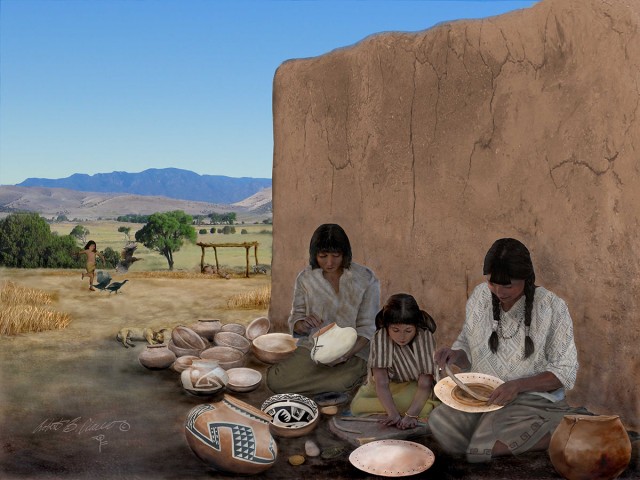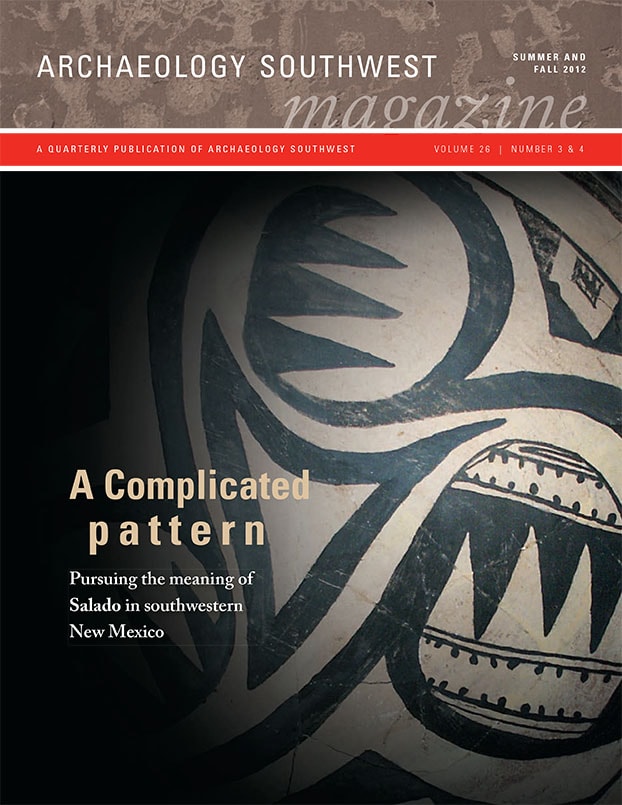A Complicated Pattern
Archaeology Southwest Magazine Vol. 26, Nos. 3 & 4
Free PDF Download
Issue editor: Deborah L. Huntley, Archaeology Southwest
Salado is, at the very least, a complicated pattern of material culture that has intrigued and vexed archaeologists for decades—most researchers would agree on that. Ideas about what Salado means, however, vary greatly. This issue presents findings of Archaeology Southwest’s investigations in southwestern New Mexico, which are part of a long-term quest to understand the meaning of Salado.
To download information about the ceramic vessels pictured in this issue (PDF), click here.
ONLINE EXCLUSIVE ESSAY: Maverick Mountain Series and Salado Polychrome Origins — Patrick D. Lyons, Arizona State Museum and Archaeology Southwest (opens as a PDF). The PDF includes a gallery of vessels from the collections of the Arizona State Museum showing details of wares and types discussed in the essay.
ONLINE EXCLUSIVE ESSAY: Geologic Diversity and Ceramic Provenance in the Greater Upper Gila Region — Deborah L. Huntley, Archaeology Southwest, and Mary F. Ownby, Desert Archaeology, Inc. (opens as a PDF)

Artist’s visualization of potters working at the fourteenth-century Salado community now known as the 3-Up site. Digital painting by Robert B. Ciaccio.
A Complicated Pattern: Pursuing the Meaning of Salado in Southwestern New Mexico — Jeffery J. Clark and Deborah L. Huntley, Archaeology Southwest
Archaeology Southwest Magazine Vol. 17, No. 3 (opens as a PDF) — Preservation Archaeology in the San Pedro Valley
Archaeology Southwest Magazine Vol. 20, No. 2 (opens as a PDF) — Archaeology on the Periphery: Recent Research in the Safford Basin
Archaeology Southwest Magazine Vol. 24, No. 4 — Following the Kayenta and Salado Up the Gila
Who or What Was Salado? — Jeffery J. Clark and Deborah L. Huntley, Archaeology Southwest
Archaeology Southwest’s long-term investigation of migration and change in the southern Southwest
Mule Creek Ecology and Settlement — J. Brett Hill, Hendrix College and Archaeology Southwest
Mule Creek slideshow
Ancient Farming and Gathering near Mule Creek — Michael W. Diehl, Desert Archaeology, Inc.
Goosefoot (Britannica Online)
Pigweed (Britannica Online)
Religious Architecture and Continuity, 1200–1450: Evidence from the Fornholt Site and Ormand Village — Katherine A. Dungan, University of Arizona and Archaeology Southwest
Archaeology Southwest Magazine Vol. 24, No. 4 — Following the Kayenta and Salado Up the Gila
Katherine’s blog posts on an earlier period at Fornholt and on 2012 fieldwork at Fornholt (part 1 and part 2)
Poster presentation on excavations at the Fornholt site, with special attention to the Tularosa phase great kiva (opens as a PDF)
Plan view of Ormand structure adapted from the following sources:
Hammack, Laurens C., Stanley D. Bussey, and Ronald Ice
1966 The Cliff Highway Salvage Project. Preliminary Report by the Museum of New Mexico, Santa Fe. On file, Archaeological Records Management Section, Historic Preservation Division, Santa Fe.
Wallace, Laurel T. (editor)
1998 The Ormand Village: Final Report on the 1965-1966 Excavation. Office of Archaeological Studies Archaeology Notes 229. Museum of New Mexico, Santa Fe.
Mule Creek Obsidian in the Time of Salado — Robert M. Jones, University of Arizona and Archaeology Southwest
Maverick Mountain Series and Salado Polychrome Origins — Patrick D. Lyons, Arizona State Museum and Archaeology Southwest
ONLINE EXCLUSIVE ESSAY: Maverick Mountain Series and Salado Polychrome Origins — Patrick D. Lyons, Arizona State Museum and Archaeology Southwest (opens as a PDF). The PDF includes a gallery of vessels from the collections of the Arizona State Museum showing details of wares and types discussed in the essay.
Collections at the Arizona State Museum
The Mills Collection at Eastern Arizona College
To download information about the ceramic vessels pictured in this issue (PDF), click here.
Pottery, Heritage, and Archaeology in the Greater Upper Gila Region, 1200–1450 — Deborah L. Huntley, Archaeology Southwest
Deb’s blog posts on ceramic analysis in the Upper Gila (part 1 and part 2) and on Salado polychrome pottery (part 1 and part 2)
Collections at the Arizona State Museum
The Mills Collection at Eastern Arizona College
To download information about the ceramic vessels pictured in this issue (PDF), click here.
Geologic Diversity and Ceramic Provenance in the Greater Upper Gila Region — Deborah L. Huntley, Archaeology Southwest, and Mary F. Ownby, Desert Archaeology, Inc.
ONLINE EXCLUSIVE ESSAY: Geologic Diversity and Ceramic Provenance in the Greater Upper Gila Region — Deborah L. Huntley, Archaeology Southwest, and Mary F. Ownby, Desert Archaeology, Inc. (opens as a PDF)
Salado Polychrome Style and Iconography — Deborah L. Huntley, Archaeology Southwest, and Patrick D. Lyons, Arizona State Museum and Archaeology Southwest
Collections at the Arizona State Museum
The Mills Collection at Eastern Arizona College
Deb’s blog posts on Salado polychrome typology and style
To download information about the ceramic vessels pictured in this issue (PDF), click here.
Perceiving the Pattern: Some Answers and New Directions — Jeffery J. Clark and Deborah L. Huntley, Archaeology Southwest
2013 Preservation Archaeology Field School curriculum
Plan for work at the Dinwiddie site
Long-term Protection of the Places of the Past: Priority Cultural Resource Assessments and the Salado Preservation Initiative — Andy Laurenzi, Archaeology Southwest
The Salado Preservation Initiative
Back Sight — William H. Doelle, Archaeology Southwest
Correction: In the map on page 4 and in the caption to the image on page 22, Redrock, New Mexico, is incorrectly given as Red Rock. We regret the error.
Subscribe

